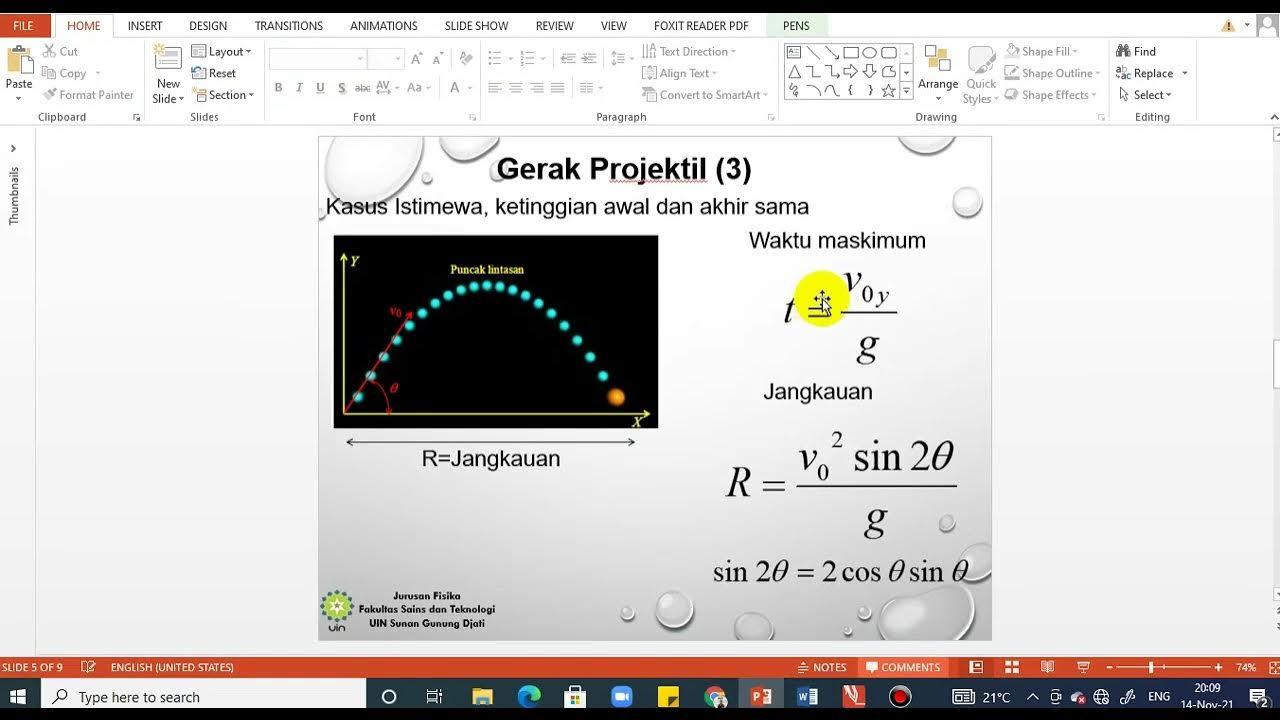Two Dimensional Motion (4 of 4) Horizontal Projection, Worked Example
Summary
TLDRIn this educational video, the host explains a two-dimensional projectile motion problem. An object is projected horizontally from a height of 45 meters with an initial velocity of 37 m/s. The video focuses on calculating the horizontal distance traveled by the object. The host clarifies that motion in the X and Y directions is independent, with zero acceleration in X and gravitational acceleration in Y. Using kinematic equations, the time of flight is determined to be 3.03 seconds, leading to a horizontal distance of 112 meters. The explanation is designed to help viewers understand the principles of projectile motion.
Takeaways
- 🎯 The problem involves calculating the horizontal distance traveled by an object in two-dimensional projectile motion.
- 📏 The object is projected from an initial height of 45 meters with an initial horizontal velocity of 37 m/s.
- 🔄 The motion in the X and Y directions are independent of each other.
- 🚫 In the X direction, there are no forces acting on the object, resulting in zero acceleration.
- 🌐 In the Y direction, the only force acting is gravity, causing a free-fall motion with an acceleration of -9.81 m/s².
- 📐 The kinematic equations are used to solve the problem, involving variables such as initial and final velocity, change in position, acceleration, and time.
- ⏱ The time taken for the object to move in the X direction is the same as the time taken to fall in the Y direction.
- 🔢 The time for the object to fall in the Y direction is calculated using the kinematic equation and the given values.
- 📉 The change in position in the Y direction is -45 meters, indicating a downward movement.
- 📏 The horizontal distance traveled in the X direction is calculated by multiplying the horizontal velocity by the time taken.
Q & A
What is the initial height from which the object is projected?
-The object is projected from an initial height of 45 meters.
What is the initial velocity of the object in the horizontal direction?
-The initial velocity of the object in the horizontal direction (X direction) is 37 meters per second.
What is the acceleration in the X direction?
-The acceleration in the X direction is zero meters per second squared because there are no forces acting on the object in that direction.
What is the acceleration in the Y direction?
-The acceleration in the Y direction is equal to the acceleration due to gravity on Earth, which is -9.81 meters per second squared.
What is the initial velocity in the Y direction for free fall motion?
-The initial velocity in the Y direction for free fall motion is 0 meters per second.
How do we determine the time it takes for the object to fall in the Y direction?
-We use the kinematic equation that relates change in position, initial velocity, time, and acceleration: \( \Delta y = v_{iy} \cdot t + \frac{1}{2} a_y \cdot t^2 \), where \( v_{iy} \) is the initial velocity in the Y direction, \( a_y \) is the acceleration in the Y direction, and \( \Delta y \) is the change in position in the Y direction.
What is the change in position in the Y direction?
-The change in position in the Y direction is -45 meters, indicating the object moves downward from its initial height.
How is the time it takes to fall in the Y direction related to the time in the X direction?
-The time it takes for the object to fall in the Y direction is the same as the time it takes to move horizontally in the X direction because the motion is simultaneous and independent in both directions.
How far does the object travel in the X direction?
-The object travels 112 meters in the X direction.
How long does it take for the object to travel the distance in the X direction?
-It takes 3.03 seconds for the object to travel the distance in the X direction.
What are the key steps to solve this projectile motion problem?
-The key steps include identifying the acceleration in both the X and Y directions, using the kinematic equations to find the time of flight in the Y direction, and then using that time to calculate the distance traveled in the X direction.
Outlines

このセクションは有料ユーザー限定です。 アクセスするには、アップグレードをお願いします。
今すぐアップグレードMindmap

このセクションは有料ユーザー限定です。 アクセスするには、アップグレードをお願いします。
今すぐアップグレードKeywords

このセクションは有料ユーザー限定です。 アクセスするには、アップグレードをお願いします。
今すぐアップグレードHighlights

このセクションは有料ユーザー限定です。 アクセスするには、アップグレードをお願いします。
今すぐアップグレードTranscripts

このセクションは有料ユーザー限定です。 アクセスするには、アップグレードをお願いします。
今すぐアップグレード関連動画をさらに表示

How Do Horizontally Launched Projectiles Behave? | Physics in Motion

Kinematics Part 3: Projectile Motion

Two Dimensional Motion Problems - Physics

Materi kuliah Fidas IF Gerak 2D

Projectile Motion Part 1| Grade 9 Science Quarter 4 Week 1 Lesson

12-88 | Engineering Dynamics Hibbeler 14th Edition | Engineers Academy
5.0 / 5 (0 votes)
